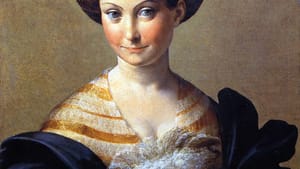Stay in the Loop
BSR publishes on a weekly schedule, with an email newsletter every Wednesday and Thursday morning. There’s no paywall, and subscribing is always free.
Who was the Turkish slave?
Parmigianino at the Frick Museum

Is it worth traveling 100 miles to see a single painting? It depends, of course, but the answer is decidedly yes when the picture is Parmigianino’s Schiava Turca, on loan to the Frick Museum from the Galleria nazionale di Parma.
Parmigianino, a.k.a. Francesco Mazzola (1503-1540), was the most celebrated painter of the generation after Michelangelo, Titian, and Raphael, although the former two were still very much active in Parmigianino’s time and in fact outlived him by 24 and 36 years, respectively. It’s this accident of mortality that has kept him from greater historical renown, at least in circles outside Italy. But that very fact may also make the Frick’s current exhibition— which like its others is focused on a single work — the ideal introduction to this master. When the work is as good as the Schiava Turca — “The Turkish Slave” — you sit up and take notice.
Another facet of the work that pricks interest is that its title is a pure misnomer that calls attention to the fact that, like the Mona Lisa or Raphael’s La Fornarina, its female subject is unknown. All we can say for sure is that she was neither Turkish nor a slave, and — oh, yes — that her likeness is one of the handful of greatest female portraits of the Italian Renaissance.
Vienna under siege
What we’re shown is a frontally posed half-length figure in very elegant aristocratic dress, topped by a turban-like headgear— actually a balzo, a fashion ornament in northern Italy at the time Schiava Turca was painted (c. 1531-1534). It’s speculated that the title was thought up by an 18th-century cataloguer at the Uffizi, where the painting once resided. If so, we mustn’t attribute this misnomer to mere ignorance of a fashion style long superseded. The Turks were more than in vogue in the 1530s; they represented a militant empire that had challenged Europe since the 14th century and, under the leadership of Suleiman the Magnificent, had only a few years previously occupied the Danube Valley and besieged Vienna. The Turks were very much part of Europe and would remain so down to the early 20th century; and in the 1530s, the question seemed rather whether Europe would become a part of Turkey.
The balzo may be seen in this light, as a cultural reference to the Ottoman menace and at the same time a celebration of the Turks’ repulse from Vienna, the greatest single political event of 16th-century Europe. The wearing of a high-fashion, Europeanized version of the ceremonial Turkish headpiece may have been a coded appropriation of the enemy’s insignia; feminizing it as an adornment of (perhaps) a court lady might have symbolized the victory of Catholic Europe over the pagan foe and possibly a riposte to the sober garb and pictorial iconoclasm of the Protestant regimes lately installed in northern Europe.
Fashion is political, and it was rarely more overtly so than in the Italian Renaissance. The suppositional cataloguer may well have been aware of this, particularly since the Turks had not long since laid siege to Vienna once again, in 1683.
As for the “slave” part of the title, that too might have had an inverted significance, since Parmigianino’s evidently well-bred subject was the very opposite of a harem girl.
A woman at ease
So, who is our mystery guest? Italian Renaissance masters sometimes used peasant girls to model for the Madonna or other Biblical figures, but Parmigianino’s lady is no travesty portrait. With her refined, cultivated features, her carefully rouged cheeks and her delicately exposed left hand, she is someone who knows her way around, even if not someone important enough to be identified or clothed in a fully serious manner. We must look for other details.
Our subject wears a fine gold bracelet, carries a white ostrich fan, and bears the emblem of Pegasus, the winged horse of Greek mythology, engraved in her balzo. These adornments suggest, as curator Aimee Ng notes in her catalogue essay, associations with literary aspirations and perhaps the muse. We’re put in mind of figures such as the contemporary poet Vittoria Colonna, though this isn’t Vittoria. Our lady may be a lesser figure or someone gotten up to represent poetic inspiration. As with the Mona Lisa, detective work takes you only so far.
What’s evident is that this young woman, who smiles so demurely yet directly at us, is perfectly at ease both in her body and her finery, borrowed as it may be. Parmigianino helps the impression along by placing her perfectly, with every pictorial element richly harmonized and balanced.
The hues of off-white, dull gold, and brown that compose the turban are reflected in the bodice, and the subtly blended, olive-drab background makes a perfect backdrop, while the rouge tint in the woman’s cheeks and the deep blue of her ruffs makes for a contrast that keeps the color scheme vivid. The tilt of the ruffs balances the slight rightward inclination of the head, which is echoed in the positioning of the hand and the fan. The two curls that peep out from under the turban add a touch of play-acting and incipient mischief. The shadow that descends from the left side of the turban down the face and neck toward the ruff adds a final touch of mystery to the whole. It is, in short, utter perfection.
Disastrous plans
The lady is not alone, but set off by four worthy companions in the Frick’s Oval Room. There are two Titians from the museum’s own collection, Portrait of a Man in a Red Cap and the famous likeness of Pietro Aretino; a Bronzino (the court page Lodovico Capponi); and another Parmigianino, a portrait of a young man from a private collection. All of them are worth (and have received) extended commentary. But in this setting, they are arrayed to set off a central jewel. You won’t find one more quietly resplendent in all of Renaissance art.
A final word, on the newly announced plans to expand the Frick. The Frick itself is a jewel, as the Morgan Library was before its recent disastrous renovation. The Frick isn’t being pirated, as the Barnes collection was, but if current plans proceed it will be destroyed from within. In this age of the museum dinosaur, nothing even relatively intimate must be allowed to remain. It is runaway art corporatism, and it is killing the public experience of art itself.
What, When, Where
The Poetry of Parmigianino’s Schiava Turca. Through July 20, 2014 at the Frick Collection, Fifth Ave. and 70th St., New York. 212-288-0700 or www.frick.org.
Sign up for our newsletter
All of the week's new articles, all in one place. Sign up for the free weekly BSR newsletters, and don't miss a conversation.

 Robert Zaller
Robert Zaller